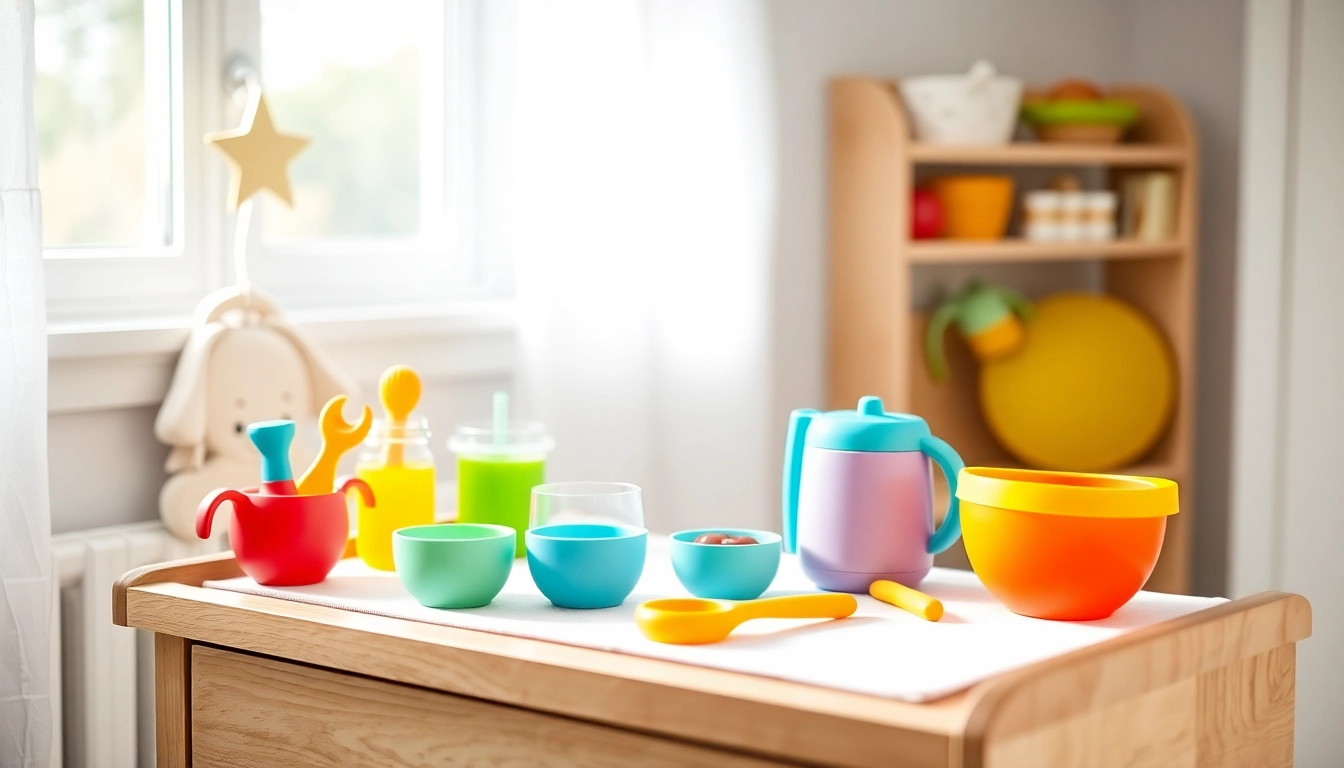Understanding the Importance of a Baby Feeding Set for Weaning
Weaning marks a pivotal phase in a baby’s development, transitioning from exclusively milk-based nutrition to a more varied diet. During this stage, the tools parents choose can significantly influence a child’s eating habits, motor skills, and independence. A well-designed Baby feeding set for weaning not only facilitates feeding but also supports sensory development, encourages self-feeding, and fosters a positive relationship with food. With the increasing emphasis on health, safety, and eco-friendliness, modern feeding sets have evolved to meet these needs, offering parents reliable solutions for nurturing their little ones effectively.
Role of Feeding Sets in Baby Skill Development
Feeding sets are more than just utensils; they serve as essential tools in developing fine motor skills, hand-eye coordination, and independence in babies. During the early stages of weaning, children learn to grasp utensils, bring food to their mouths, and manage different textures, all of which are crucial for their overall growth. For example, specially designed ergonomic spoons and forks in silicone help children develop dexterity, while divided plates and bowls teach portion control and organizational skills. These tools also stimulate sensory exploration—feeling different textures improves tactile awareness, and the vibrancy of colorful silicone dinnerware engages visual senses. Ultimately, a thoughtfully chosen feeding set can transform mealtime from a challenging task into a fun, educational experience that promotes confidence and autonomy.
Key Features to Consider for Safe and Effective Weaning
Safety and Certification
Safety is paramount when selecting a baby feeding set. Look for products made from food-grade, BPA-free, and phthalate-free silicone or other certified non-toxic materials. Certifications from reputable standards bodies such as SGS or CE ensure compliance with strict safety regulations, reducing risks of harmful chemicals leaching into food. Additionally, smooth, rounded edges, sturdy construction, and non-slip bases prevent accidents and spills.
User-friendly Design
Ease of use is vital for both baby and parent. Items with suction bases, like silicone bowls or plates, keep the set stable during independent eating, minimizing messes and frustration. Ergonomic handles and lightweight utensils designed for small hands enhance grip and coordination, making self-feeding more manageable. Multi-compartment dishes support varied diets and make it easier for babies to explore different tastes and textures within a single meal.
Functionality and Aesthetics
Functional features such as removable dividers, stackable containers, and heat-resistant materials add convenience, while playful designs and vibrant colors foster engagement. Combining fun aesthetics with practicality encourages repeated use and positive associations with mealtime.
Benefits of Using Silicone and Eco-Friendly Materials
Silicone has emerged as the material of choice for baby feeding sets due to its resistance to heat, flexibility, and non-toxic properties. Unlike plastics that may contain BPA and other harmful chemicals, high-quality silicone is inert, hypoallergenic, and easy to sanitize. Its durability ensures longevity as it withstands drops, bites, and repeated sterilization cycles, making it a cost-effective investment. Furthermore, eco-friendly silicone options are biodegradable and free from phthalates and PVC, aligning with sustainable parenting practices. This choice also reduces environmental impact and supports health-conscious families seeking natural, safe solutions for their children.
Selecting the Right Baby Feeding Set for Weaning
Essential Components of an Ideal Feeding Set
An optimal feeding set combines several key elements: divided plates with non-slip bases to segment different foods, suction bowls for stability, ergonomic utensils adapted for tiny hands, and durable cups or sippy options. For versatile use, look for sets with removable components so they can grow with your baby’s evolving needs. Consider including a set of training utensils—such as softly curved spoons or multi-textured forks—designed to promote motor skill development.
How to Evaluate Safety Standards and Certifications
Before purchasing, verify that each product adheres to safety standards relevant in your country. Seek certifications such as CE or FDA approval, and check for independent safety testing reports. Read product labels carefully to confirm the absence of BPA, phthalates, lead, or other toxic substances. Transparency from brands regarding material sourcing and manufacturing processes adds an extra layer of confidence.
Matching the Set to Your Baby’s Age and Eating Habits
Age-appropriate sets are tailored to developmental stages—smaller, softer utensils for those starting self-feeding, and more complex dishes as coordination improves. For babies just beginning to explore solids, simple and lightweight utensils with textured grips work best. As they progress, multi-compartment dishes and spill-proof cups support growing independence. Monitoring your child’s motor skills and adjusting the tools accordingly ensures a smoother transition to independent eating.
Integrating the Baby Feeding Set into Daily Routines
Tips for Encouraging Independent Eating
Creating a positive mealtime environment encourages babies to become autonomous eaters. Offer the feeding set within a routine that emphasizes patience, gentle encouragement, and praise. Demonstrate how to hold utensils, and let your child imitate you. Using colorful, engaging plates and bowls can motivate curiosity and participation. Allowing supervised, unhurried practice fosters confidence and reinforces self-feeding skills.
Creating Engaging Mealtime Experiences
Turning meals into interactive moments stimulates learning. Incorporate stories or songs during feeding, offer a variety of textures and flavors, and involve children in simple prep tasks like choosing their utensils. Using vibrant silicone dinnerware designed with playful motifs, such as animals or rainbow shapes, makes the experience joyful and memorable. Consistent exposure to diverse foods and utensils builds familiarity, reducing resistance and encouraging exploration.
Overcoming Common Challenges with Weaning Tools
Many parents face issues like spills, resistance to utensils, or limited coordination. Solutions include selecting suction-based dishes to prevent tipping, choosing utensils with ergonomic grips, and practice patience. Introducing new tools gradually and modeling proper use helps children adapt more quickly. Regular cleaning and inspection of utensils ensure safety, while persistent reassurance and encouragement foster a positive attitude toward new eating experiences.
Maintaining and Caring for Your Baby Feeding Set
Cleaning and Sanitizing Silicone Utensils
Proper maintenance extends the lifespan of your feeding set. Silicone items are dishwasher safe, but hand washing with mild, non-abrasive soap and warm water is recommended to preserve their integrity. Sterilization can be achieved by boiling or steaming, which eliminates bacteria without damaging the material. Keep utensils dry and store them in a clean, dry place to prevent mold or deterioration.
Extending the Lifespan of the Feeding Set
Avoid using abrasive cleaners or sharp tools that can scratch silicone surfaces. Regularly check for cracks, discoloration, or signs of wear, and replace items if necessary. Rotating utensils and dishwasher cleaning help maintain their appearance and functionality. Proper storage—away from direct sunlight or extreme temperatures—also preserves their quality over time.
Recognizing Signs of Wear and When to Replace
Indicators include cracks, tears, persistent staining, or a change in texture that affects safety or usability. If utensils become difficult to clean or show any damage, it’s time for replacement to ensure ongoing safety and hygiene.
Expert Insights and Real-Life Testimonials
Parent Experiences with Different Feeding Sets
Many parents report that using silicone, suction-based plates, and ergonomic utensils greatly reduces mealtime stress. For example, Elisa, a mother of two, shares that her child’s independence increased significantly when using brightly colored, stabile dishes. She emphasizes the importance of choosing non-toxic materials to ensure safety during frequent use.
Expert Recommendations on Weaning Tools
Child nutritionists highlight the significance of selecting tools that promote self-feeding without creating messes or safety concerns. They recommend starting with simple, durable, and easy-to-handle utensils, gradually introducing more complex dishes and cups as the child’s skills develop. Experts also advocate for tools made from high-quality, eco-friendly silicone that supports health and sustainability.
Case Studies of Successful Transition to Independent Eating
Studies show that children using comprehensive, well-designed feeding sets achieve milestones earlier, like self-feeding and chew-and-swallow skills. For instance, a case in Italy demonstrated that children using colorful, segmented silicone plates with suction bases transitioned smoothly to independent eating, fostering confidence and reducing parental stress.








